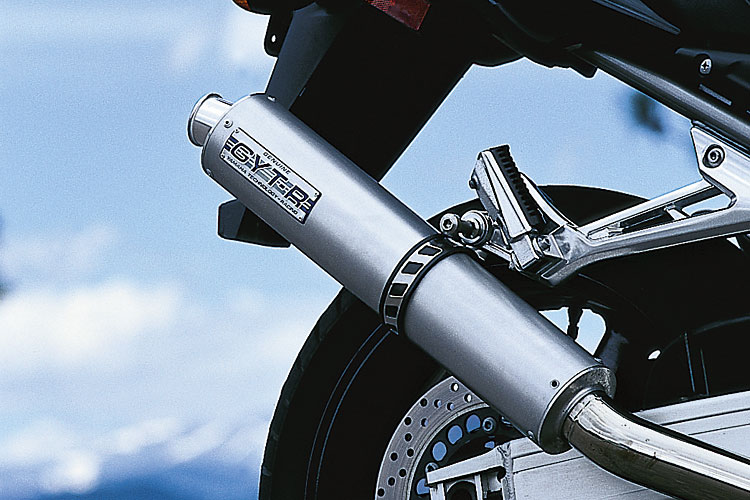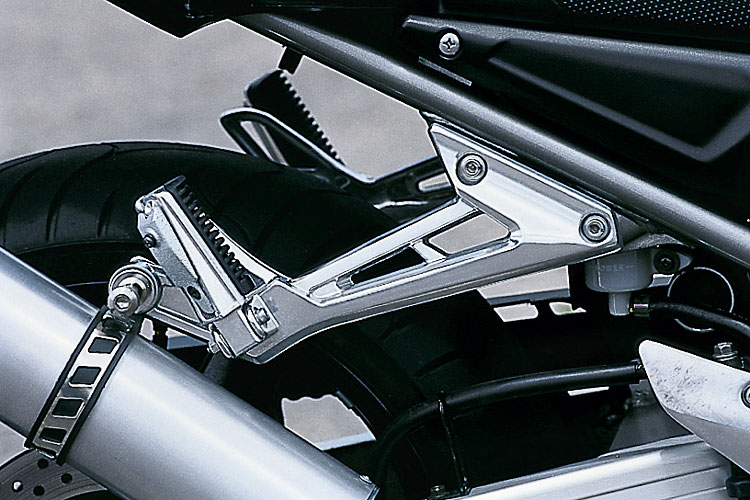Yamaha FZ1

The idea of converting a sportbike into a standard isn't new at all. But the better the material you start with, the greater your results at the end. The transformation of Yamaha's R1 into the FZ1 demonstrates that impressively.
If you have ever switched from a comfy but heavy touring bike to a pure sportbike with few accessories, you've felt something close to weightlessness. All of a sudden turns are a lot easier and steering with your hips only is almost possible. RoadRUNNER Motorcycle Cruising & Touring got the chance to ride Yamaha's sporty standard FZ1 on twisty roads in the Alps and on tracks in Southern Europe as well as some wild mountain roads in Colorado. Walking two feet off the ground, our testers returned with smirks on their faces and acted like they'd just hit the lottery.
Concept & Transformation
Yamaha didn't just start with an old concept and add some new looks and accessories. They rearranged the beefy R1 five-valve engine for better street bike performance, mounted it in a sturdy double-cradle steel frame, and adopted the current Yamaha supersports design with aggressive headlight eyes. Only a few will be able to resist it. The rest will lose their hearts.

Yamaha USA made a wise decision to import and sell this bike. Now this standard isn't only available for European enthusiasts, which often has been the case with other bikes in the past. America is more than ready for 'street fighters,' as the Brits and Germans call 'em. Eddie Lawson isn't the only bloke who likes to go naked!
Engine & Transmission
There couldn't have been a better choice for the power resource than this amazing R1 engine: a liquid-cooled inline-four with two overhead cams, five valves per cylinder, EXUP-exhaust-valve and an air-induction system for cleaner emissions. For better street-riding capability some changes were made to broaden the usable power range. Compared to the R1, the FZ crankshaft is ten percent heavier, which makes the power output smoother and better to deal with when you go on the throttle. The altered frame design made another layout for the cylinder head necessary with the carbs now mounted more horizontally. Instead of 40mm downdrafts, you get 37mm conventional carbs and the airbox now has one liter less capacity. These changes added more available space for a fuel tank that measures an excellent 21 liters (5.5 gallons). Cams, valves and springs remain the same as the R1's, only the timing changed. The wet clutch received smaller plates with one more driving and one more driven disc. Also, the exhaust system is new; the stainless steel unit now leaves enough space to mount a center stand. Our U.S. test bike, contributed by Andy Holobinko from Motoranch in Golden, Colorado, was equipped with a GYTR pipe (Genuine Yamaha Technology Racing) that didn't require removal of the center stand. The pipe improved breathing of the engine as well as midrange and top-end power output.

Change is usually accompanied with compromises, but don't worry - they didn't convert the inline-four into a weak power plant. When you hit the street and pull this throttle, you'll be surprised by the engine's response. Starting at idling level on the tach, the FZ pulls through the wide powerband like a rutting bull and ends up pushing out 141 very wild horses at 9,500 rpm in the U.S. version. The maximum torque is 80 ft. lbs. at 7,500 rpm. On public roads this gives you plenty of performance to play with. The sprint from a standing start to 65mph takes just a tad more than three seconds. And if you don't watch out, the front wheel comes up. But otherwise the power output is easy to manage; even people moving up from smaller capacities can handle it.
Regarding changes to the clutch, shifting the FZ1 gearbox is definitely easier and more comfortable than the slightly hard to operate and noisy R1 counterpart. The only thing that bugs me about the FZ1 motor is the fine vibrations that occur mostly in the midrange even though the engine is rubber mounted in the front (note: the engine is no longer a stressed member like the R1!).
Chassis & Brakes
The good thing about the new, steel tubular frame and, of course, the nice little bikini fairing is that you can see the silver-painted engine much better. Yamaha's engineers worked wonders developing this chassis. The aluminum swingarm is not only good looking - it's rigid and sturdy enough for the racetrack. Don't even expect the slightest tendency to flex; these wild horses are very well controlled.

It is also obvious Yamaha didn't cut any corners or spare any costs by removing adjustments for the 43mm forks or the piggyback shock. Both units work very well on public roads and at the racetrack. The same goes for those wonderful brakes with 296mm rotors and four-piston calipers in the front. Even the rear brake shows the same level of sensitivity and braking power, especially when you might need it most of all, with a passenger on the back seat.
Accessories & Arrangements
Of course, there are differences compared to the pure sportbike R1. The fairing is much smaller and it doesn't give you great wind protection at all. But you get an all-round standard bike that works for more purposes (touring, everyday, or canyon riding) and the comfy upholstery of the rear seat increases the likelihood your sweetheart will be happy to join you on those trips. Adding a tank bag and some soft-case saddlebags prepares it well for longer distances while the center stand makes maintaining and loading the bike a lot easier.
Another thing changed on our test bike was the mounting hardware for the handlebars. The OEM rubber-mounted item was way too high and interfered with the feedback from the front wheel. Now, with the GYTR kit, steering and front-end response are improved tremendously.

Test Summary
No doubt about it, the FZ1 is one of the most exciting bikes for this year. And it's worth every single buck you'll have to lay out: $ 8,499 is a terrific deal for a bike that combines sportbike spirit and performance with the comfort you need for everyday riding!
Technical Specs
Retail price $ 8,499WarrantyOne year
Maintentance schedule 600/4,000/every 4,000 miles or every 6 months (1,000/6,400/every 6,400 km)
Importer/distributor Yamaha Motor Corp., U.S.A.
6555 Katella Ave.,
Cypress, CA 90630,
phone (800) 962-7926
or (714) 761-7300,
fax (714) 761-7303
Engine
Type 4-cylinder, inline, 4-stroke
Cooling Water-cooled
Valve arrangement 5 valves per cyl., dohc, cams chain driven, shim under bucket adjustment
Bore & stroke 74 x 58 mm
Displacement 998 cc
Compression ratio 11.4:1
Carburetion Four Mikuni carburetors, Ø 37 mm
Transmission
Gearbox 6-speed
Clutch Multi-plate wet clutch
Final drive Chain drive
Chassis
Frame Steel tubular frame, double cradle
Wheelbase 1,450 mm (57.1 in.)
Rake 64 degree
Trail 104 mm (4.1 in.)
Front suspension Inverted cartridge fork
Stanchion diameter43 mm (1.38 in.)
Adjustments Spring preload, compression and rebound damping
Travel 140 mm (5.5 in.)
Rear suspension Alloy swingarm w/single shock
Adjustments Spring preload, compression and rebound damping
Travel 135 mm (5.3 in.)
Wheels & Tires
Type Cast alloy wheels
Front 3.50 x 17
Rear 5.50 x 17
Front Tire 120/70 ZR 17
Rear Tire 180/55 ZR 17
Brakes
Front brake 2 discs, 4-piston calipers
Diameter 298 mm (11.7 in.)
Rear brake 1 disc, 2-piston caliper
Diameter 245 mm (9.6 in.)
Combining no
Weight & Fuel Capacity
Wet-Weight 233 kg (518 lb.)
Fuel capacity 21 l (5.5 gal.)
Performance
Claimed Horsepower (crank) 143 hp at 10,000 rpm (US: 141 hp at 9,500 rpm)
Torque 10.8 mkp (80 ft. lbs.) at 7,500 rpm (US: 10.5 mkp/78 ft.lbs. at 7,500 rpm)
Top speed 250 km/h (156 mph)
Acceleration 0-100 km/h (0-62.5 mph): 3.0 s
Fuel consumption 6.5 l/100 km (36.5 mpg)
Fuel range 323 km (202 miles)
Equipment
Half fairing, dashboard w/speedometer, tachometer and fuel gauge, digital gauges for clock and odometer, key switch in front of the upper triple clamp, adjustable brake lever, center stand and side stand.
RoadRUNNER Test Diagram
Engine 5/5
Chassis 5/5
Brakes 5/5
Comfort 3/5
Luggage w/accessories 2/5
Equipment 3/5
Design 4/5
Bike for the buck 5/5






